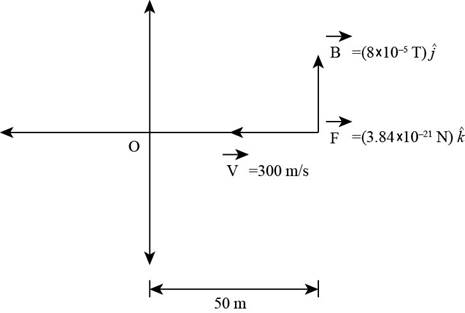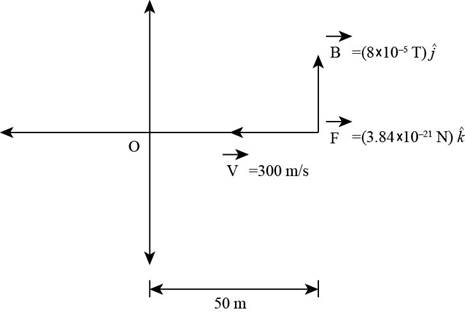
Concept explainers
In a long, .straight, vertical lightning stroke, electrons move downward and positive ions move upward and constitute a current of magnitude 20.0 kA. At a location 50.0 m east of the middle of the stroke, a free electron drifts through the air toward the west with a speed of 300 m/s. (a) Make a sketch showing the various vectors involved. Ignore the effect of the Earth's magnetic field. (b) Find the vector force the lightning stroke exerts on the electron. (c) Find the radius of the electron’s path. (d) Is it a good approximation to model the electron as moving in a uniform field? Explain your answer. (e) If it does not collide with any obstacles, how many revolutions will the electron complete during the 60.0-µs duration of the lightning stroke?
(a)
To draw: The various vectors involved to represent the lightning stroke of the electron and the positive ions.
Answer to Problem 30.16P
The various vectors involved to represent the lightning stroke of the electron and the positive ions as shown below,

Explanation of Solution
Given info: The electrons move downward and the positive ions move upwards. The magnitude of the uniform current is
According to the Ampere’s right hand thumb rule, the index finger represents the direction of the velocity vector
Write the expression for the magnetic field.
Here,
Substitute
Write the expression for the direction of the magnetic field according to the ampere’s law of the magnetic field.
Write the expression for the velocity vector pointed towards the west.
Write the expression for the force vector on the electron,
Here,
Substitute
From the result of the force vector, field vector and velocity vector the as shown below,

Figure (1)
(b)
The vector force lightning stroke exert on the electron.
Answer to Problem 30.16P
The vector force lightning stroke exert on the electron is
Explanation of Solution
Given info: The electrons move downward and the positive ions move upwards. The magnitude of the uniform current is
From the part (a), the vector force on the electron.
Conclusion:
Therefore, the vector force lightning stroke exert on the electron is
(c)
The radius of the electron path.
Answer to Problem 30.16P
The radius of the electron path is
Explanation of Solution
Given info: The electrons move downward and the positive ions move upwards. The magnitude of the uniform current is
Write the expression for the radius of the electron path.
Here,
Substitute
Conclusion:
Therefore, the radius of the electron path is
(d)
Whether it is a good approximation to model the electron as moving in a uniform field.
Answer to Problem 30.16P
The electron was not moving in a uniform field cause of the magnetic field is varies from the location of the lightning stroke.
Explanation of Solution
Given info: The electrons move downward and the positive ions move upwards. The magnitude of the uniform current is
From the figure (1) of the part (a), the magnitude of the magnetic field is varies with the distance of the light stroke towards the positive
Conclusion:
Therefore, the electron was not moving in a uniform field cause of the magnetic field is varies from the location of the lightning stroke.
(e)
The number of the revolutions will the electron complete during the
Answer to Problem 30.16P
The number of the revolutions will the electron complete during
Explanation of Solution
Given info: The electrons move downward and the positive ions move upwards. The magnitude of the uniform current is
From the part (c) the radius of the electron path,
Write the expression for the number of the revolution complete by the electron.
Here,
Substitute
Conclusion:
Therefore, the number of the revolutions will the electron complete during
Want to see more full solutions like this?
Chapter 30 Solutions
EBK PHYSICS FOR SCIENTISTS AND ENGINEER
- What magnetic field is required in order to confine a proton moving with a speed of 4.0 × 106 m/s to a circular orbit of radius 10 cm?arrow_forwardA proton travels with a speed of 3.00 106 m/s at an angle of 37.0 with the direction of a magnetic field of 0.300 T in the +y direction. What are (a) the magnitude of the magnetic force on the proton and (b) its acceleration?arrow_forwardA charged particle is traveling through a uniform magnetic field. Which of the following statements are true of the magnetic field? There may be more than one correct statement. (a) It exerts a force on the particle parallel to the field. (b) It exerts a force on the particle along the direction of its motion. (c) It increases the kinetic energy of the particle. (d) It exerts a force that is perpendicular to the direction of motion. (e) It does not change the magnitude of the momentum of the particle.arrow_forward
- If a charged particle moves in a straight line, can you conclude that there is no magnetic field present?arrow_forwardA particle moving downward at a speed of 6.0106 m/s enters a uniform magnetic field that is horizontal and directed from east to west. (a) If the particle is deflected initially to the north in a circular arc, is its charge positive or negative? (b) If B = 0.25 T and the charge-to-mass ratio (q/m) of the particle is 40107 C/kg. what is ±e radius at the path? (c) What is the speed of the particle after c has moved in the field for 1.0105s ? for 2.0s?arrow_forwardA cosmic-ray proton in interstellar space has an energy of 10.0 MeV and executes a circular orbit having a radius equal to that of Mercury’s orbit around the Sun (5.80 × 1010 m). What is the magnetic field in that region of space?arrow_forward
- (a) A cosmic ray proton moving toward the Earth at 5.00107m/s experiences a magnetic force of 1.701016N. What is the strength of the magnetic field it there is a 45° angle between it and the proton’s velocity? (b) Is the value obtained in part (a) consistent with the known strength of the Earth’s magnetic field on its surface? Discuss.arrow_forwardCalculate the magnitude of the magnetic field at a point 25.0 cm from a long, thin conductor carrying a current of 2.00 A.arrow_forwardThe accompanying figure shows a cross-section of a long, hollow, cylindrical conductor of inner radius r1= 3.0 cm and outer radius r2= 5.0 cm. A 50-A current distributed uniformly over the cross-section flows into the page. Calculate the magnetic field at r = 2.0 cm. r = 4.0 cm. and r = 6.0 cm.arrow_forward
- A current of 1.2 A is flowing in a coaxial cable whose outer radius is five times its inner radius. What is the magnetic field energy stored in a 3.0-m length of the cable?arrow_forward12.4 Check Your Understanding Two wires, both carrying current out of the page, have a current of magnitude 2.0 mA and 3.0 mA, respectively. The first wire is located at (0.0 cm, 5.0 cm) while the other wire is located at (12.0 cm, 0.0 cm). What is the magnitude of the magnetic force per unit length of the first wire on the second and the second wire on the first?arrow_forwardA laboratory electromagnet produces a magnetic field of magnitude 1.50 T. A proton moves through this field with a speed of 6.00 106 m/s. (a) Find the magnitude of the maximum magnetic force that could he exerted on the proton. (b) What is the magnitude of the maximum acceleration of the proton? (c) Would the field exert the same magnetic force on an electron moving through the field with the same speed? (d) Would the electron experience the same acceleration? Explain.arrow_forward
 Physics for Scientists and Engineers, Technology ...PhysicsISBN:9781305116399Author:Raymond A. Serway, John W. JewettPublisher:Cengage Learning
Physics for Scientists and Engineers, Technology ...PhysicsISBN:9781305116399Author:Raymond A. Serway, John W. JewettPublisher:Cengage Learning College PhysicsPhysicsISBN:9781305952300Author:Raymond A. Serway, Chris VuillePublisher:Cengage Learning
College PhysicsPhysicsISBN:9781305952300Author:Raymond A. Serway, Chris VuillePublisher:Cengage Learning College PhysicsPhysicsISBN:9781285737027Author:Raymond A. Serway, Chris VuillePublisher:Cengage Learning
College PhysicsPhysicsISBN:9781285737027Author:Raymond A. Serway, Chris VuillePublisher:Cengage Learning Physics for Scientists and EngineersPhysicsISBN:9781337553278Author:Raymond A. Serway, John W. JewettPublisher:Cengage Learning
Physics for Scientists and EngineersPhysicsISBN:9781337553278Author:Raymond A. Serway, John W. JewettPublisher:Cengage Learning Physics for Scientists and Engineers with Modern ...PhysicsISBN:9781337553292Author:Raymond A. Serway, John W. JewettPublisher:Cengage Learning
Physics for Scientists and Engineers with Modern ...PhysicsISBN:9781337553292Author:Raymond A. Serway, John W. JewettPublisher:Cengage Learning Principles of Physics: A Calculus-Based TextPhysicsISBN:9781133104261Author:Raymond A. Serway, John W. JewettPublisher:Cengage Learning
Principles of Physics: A Calculus-Based TextPhysicsISBN:9781133104261Author:Raymond A. Serway, John W. JewettPublisher:Cengage Learning





